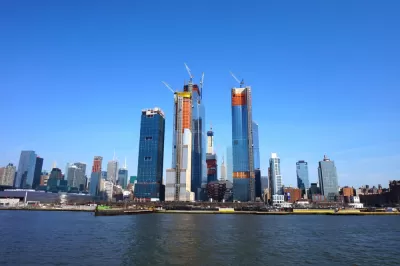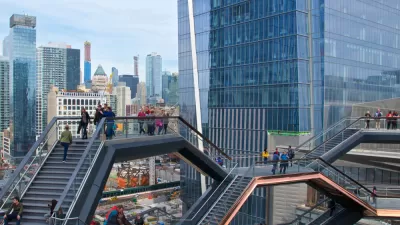The developers of Hudson Yards received $1.2 billion in financing from the EB-5 program, all made possible by a map that gerrymandered the project into the same neighborhood as Harlem public housing.

Kriston Capps reports on the financial deal that helped finance the Hudson Yards mega-project in New York City. Bolstering a point that heavily criticized design choices are not the component of the project most deserving our contempt. Capps explains that reasoning:
Without their knowledge, the residents of a number of public housing developments helped to make Hudson Yards possible. The mega-luxury of this mini-Dubai was financed in part through a program that was supposed to help alleviate urban poverty. Hudson Yards ate Harlem’s lunch."
Specifically, the project raised at least $1.2 billion of its financing through a controversial investor visa program known as EB-5. This program enables immigrants to secure visas in exchange for real estate investments. Foreigners who pump between $500,000 and $1 million into U.S. real estate projects can purchase visas for their families, making it a favorite for wealthy families abroad, namely in China. EB-5 is supposed to be a way to jumpstart investment in remote rural areas, or distressed urban ones.
Related Companies, the developer of Hudson Yards, "raked in" at least $1.2 billion in EB-5 funds for the project, despite the project being "nobody's idea of distressed."
So how did Related Companies manage to qualify for the project? A highly gerrymandered map, created by Empire State Development, the economic development agency for the state of New York.
New York state “gerrymandered” a map to qualify Hudson Yards for $1.6 billion in financing meant for low-income areas—by threading it to public housing in Harlem. @kristoncapps reports:https://t.co/71yXG5KqIl pic.twitter.com/gX3PrCHlex
— CityLab (@CityLab) April 21, 2019
As note by Capps, the Hudson Yards project is one symptom of larger problems with the EB-5 program, and not just an example of systematic failures of New York real estate.
Sophie Kasakove provides additional follow-up coverage of Capps's reporting, tying the EB-5 story of Hudson Yards to controversies created by the use of tax increment financing in Chicago.
FULL STORY: The Hidden Horror of Hudson Yards Is How It Was Financed

Study: Maui’s Plan to Convert Vacation Rentals to Long-Term Housing Could Cause Nearly $1 Billion Economic Loss
The plan would reduce visitor accommodation by 25,% resulting in 1,900 jobs lost.

North Texas Transit Leaders Tout Benefits of TOD for Growing Region
At a summit focused on transit-oriented development, policymakers discussed how North Texas’ expanded light rail system can serve as a tool for economic growth.

Why Should We Subsidize Public Transportation?
Many public transit agencies face financial stress due to rising costs, declining fare revenue, and declining subsidies. Transit advocates must provide a strong business case for increasing public transit funding.

How to Make US Trains Faster
Changes to boarding platforms and a switch to electric trains could improve U.S. passenger rail service without the added cost of high-speed rail.

Columbia’s Revitalized ‘Loop’ Is a Hub for Local Entrepreneurs
A focus on small businesses is helping a commercial corridor in Columbia, Missouri thrive.

Invasive Insect Threatens Minnesota’s Ash Forests
The Emerald Ash Borer is a rapidly spreading invasive pest threatening Minnesota’s ash trees, and homeowners are encouraged to plant diverse replacement species, avoid moving ash firewood, and monitor for signs of infestation.
Urban Design for Planners 1: Software Tools
This six-course series explores essential urban design concepts using open source software and equips planners with the tools they need to participate fully in the urban design process.
Planning for Universal Design
Learn the tools for implementing Universal Design in planning regulations.
Ascent Environmental
Borough of Carlisle
Institute for Housing and Urban Development Studies (IHS)
City of Grandview
Harvard GSD Executive Education
Toledo-Lucas County Plan Commissions
Salt Lake City
NYU Wagner Graduate School of Public Service





























